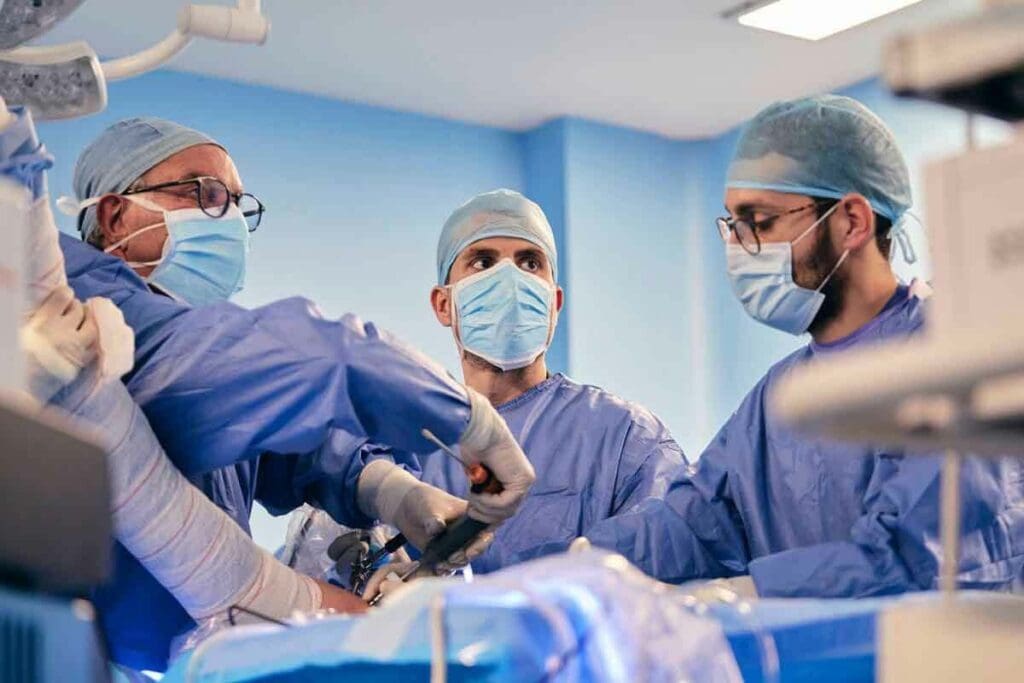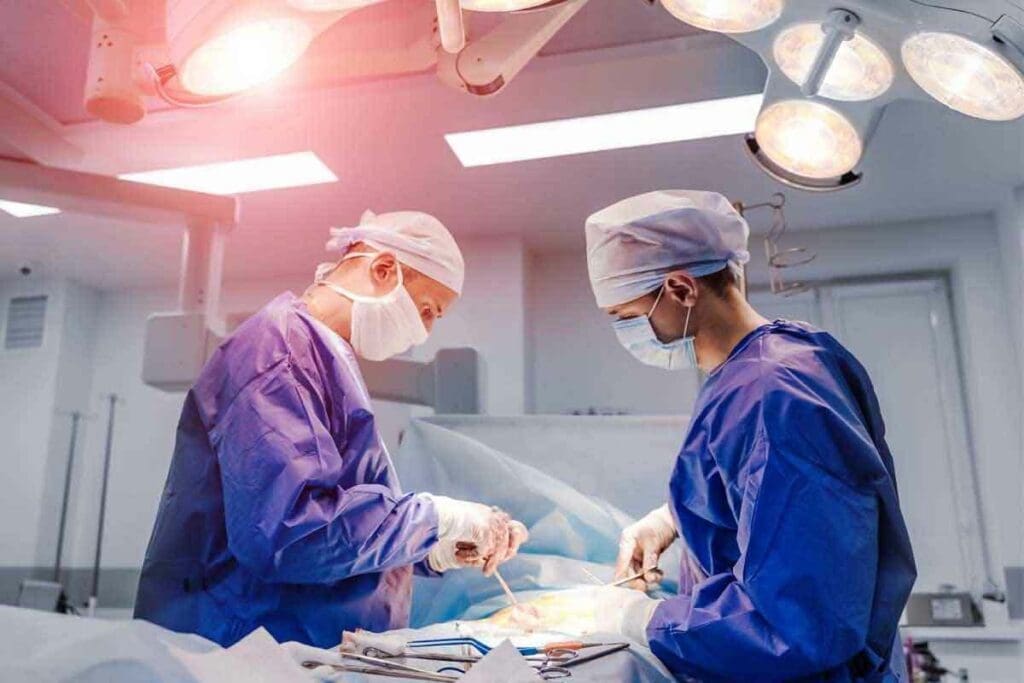Last Updated on November 17, 2025 by Ugurkan Demir

Donating bone marrow is a powerful act that can save someone’s life. However, it’s important to understand what to expect after the procedure, including the bone marrow donation scar and possible side effects.
At Liv Hospital, donor safety is our top priority. We follow international medical standards to ensure a smooth and safe recovery. Most donors experience only a small bone marrow donation scar at the site where the marrow was collected, usually on the lower back or hip area. This scar typically fades over time and causes minimal discomfort.
Understanding the risks, healing process, and appearance of the bone marrow donation scar helps donors make informed choices and feel confident about their decision to help others.

Bone marrow donation is a life-saving process. It’s a key treatment for serious diseases. We’re learning more about it every day. This method can greatly help patients with cancers, blood disorders, and other serious health issues.
Bone marrow is the soft tissue in some bones, like the hips and thighbones. It makes blood cells. It’s full of stem cells, which can turn into different blood cells. Donating bone marrow can replace a patient’s bad marrow with healthy marrow, possibly curing their disease.
The donation process is detailed. It matches donors with recipients to avoid problems. The donated stem cells can help patients recover from diseases that harm their marrow.
There are two main bone marrow donation methods: bone marrow harvest and peripheral blood stem cell (PBSC) donation.
Both methods have their own side effects and considerations. We’ll talk about them later.
| Procedure | Description | Recovery Time |
| Bone Marrow Harvest | Surgical removal of bone marrow from the hip bones under anesthesia. | Several weeks |
| PBSC Donation | Collection of stem cells from the bloodstream after stimulation. | A few days to a week |
Doctors say, “The choice between bone marrow harvest and PBSC donation depends on various factors, including the recipient’s condition and the donor’s health.”

When you think about bone marrow donation, knowing about scarring is key. The process uses a needle in the back of the hip. This can leave a scar.
The scar is usually on the back of the hip. Its size depends on your body and the doctor’s method.
Many things can change how a scar looks and feels. These include:
The healing of the bone marrow donation scar goes through several stages:
| Timeframe | Healing Stage | Care Tips |
| 0-2 weeks | Initial wound healing | Keep the area clean and dry, follow the doctor’s instructions |
| 2-6 weeks | Scab formation and initial scar development | Avoid picking at scabs. Gently massage the area |
| 6 weeks-6 months | Scar maturation | Continue gentle massage, consider silicone gel or sheeting |
To make the scar less noticeable, follow the care tips given. Using silicone products or a gentle massage can help.
Knowing about scarring and taking steps to prevent it can make donors feel more ready for the process.
Thinking about bone marrow donation? Knowing the journey from start to finish is key. It’s all about keeping both the donor and the recipient safe and healthy.
The first step is a detailed medical check-up. This is vital to see if you’re a good match. It includes tests and exams to check your health and match you with the recipient.
During this check-up, donors do several things:
| Test/Evaluation | Purpose |
| Blood Tests | Check for infectious diseases and assess blood type compatibility |
| Physical Examination | Evaluate overall health |
| Medical History Review | Identify any pre-existing conditions |
| Tissue Typing | Ensure compatibility with the recipient |
On donation day, a team of doctors will guide you through. The donation method can be a bone marrow harvest or a peripheral blood stem cell collection.
Bone Marrow Harvest: This is done under general anesthesia. It takes marrow from the hip bone using a needle and syringe.
Peripheral Blood Stem Cell Collection: This method makes your body release stem cells into your blood. Then, a special machine collects them.
After donating, you’ll be watched closely for any issues. Proper care is key to a smooth recovery.
Donors should:
Learning about the bone marrow donation process helps prepare you for this important act.
Bone marrow donation can be rewarding, but it comes with risks. It’s important to know these risks before deciding to donate.
One major risk is complications from anesthesia. Anesthesia-related complications can be mild or severe. It’s key to talk about your health with your doctor before donating.
There’s a chance of infection at the donation site. This risk is lowered with good wound care and follow-up care. Keep an eye on your health after donating.
Nerve or tissue damage is a possible risk. It can happen from the needle or the harvesting process. Though rare, it can have lasting effects.
Bleeding can happen during or after donation. Bleeding risks are managed with close medical watch. Know the signs of too much bleeding.
The next three risks are:
IDonors need to considerthese risks and the benefits of donation.
Knowing the risks and how to reduce them helps donors make informed choices about donating bone marrow.
Bone marrow donation is a life-saving act,, but can cause physical and emotional side effects for donors. It’s important for those thinking about donating to know about these possible effects.
Donors may face several physical side effects after donating bone marrow. These include:
These side effects are usually short-term and can be managed with proper care after donation. For more information on managing these effects, donors can look at resources like the American Cancer Society.
Donors may also face emotional and psychological side effects. These can include:
It’s key for donors to have a support system for these emotional and psychological aspects. Talking to healthcare providers about expectations and experiences can also help manage any negative feelings.
Understanding both physical and emotional side effects of bone marrow donation helps donors make informed choices about their involvement.
It’s important for those thinking about bone marrow donation to know the risks. We look at the data on complications to give a clear view of what donors might face.
About 2.4% of bone marrow donors face serious complications. This number comes from detailed studies on donor outcomes. Serious complications are life-threatening and need quick medical help.
A big study with thousands of donors showed us the risks. It broke down complications into minor and major, helping us understand the dangers better.
Complications from bone marrow donation can be minor or major. Minor ones are short-term and easy to handle. Major ones can last a long time.
| Type of Complication | Percentage of Donors | Examples |
| Minor Complications | 15% | Pain, fatigue, bruising |
| Major Complications | 2.4% | Infection, nerve damage, bleeding |
Research othe n long-term effects of bone marrow donation is ongoing. Most donors get better, but some may have chronic pain or fatigue. Knowing these effects helps donors make informed choices.
We keep up with the latest research to give accurate information to those considering donation.
Bone marrow donation is a lifesaving act, but it’s often misunderstood. Many people are scared of the risks. We want to clear up these myths by looking at the facts.
Many think bone marrow donation is very dangerous and painful. But new medical technology and donation methods have made it much safer.
Another myth is that it causes long-term health problems. But,most donors get better in just a few weeks. Serious problems are very rare, happening in less than 2.4% of cases, studies show.
Many studies have looked into bone marrow donation safety. They found that the risks are similar to other surgeries. For example, a study showed ththat e risk of serious problems is lower than many surgeries.
Also, donor safety rules are very strict. These include checking donors before, during, and after the donation.
Driving a car is much riskier than donating bone marrow. Many everyday things, like driving or exercising, have risks we accept.
By comparing these risks, we see that donating bone marrow is relatively safe. This helps to reduce fears and encourages more to donate.
Recovering from bone marrow donation is key. It needs careful attention and care after donation. Knowing the recovery process helps you prepare and heal smoothly.
The recovery time varies for each person. Most donors start feeling better in a few days to weeks. Medical research shows it usually takes 2-4 weeks for the body to replace bone marrow cells.
“The recovery is quite manageable,” says Expert, a bone marrow transplant expert. “Most donors can get back to normal in a month.”
It’s important to manage discomfort after donation. Donors might feel sore, stiff, or tired. To help, try:
Always follow your doctor’s instructions for care after donation. This helps avoid complications and speeds up recovery.
Most donors recover well, but knowing when to seek help is key. If you have severe pain, swelling, fever, or signs of infection, call your doctor right away.
Knowing these signs and acting quickly can greatly improve your recovery.
It’s important to know the risks of bone marrow donation compared to other medical procedures. This helps donors make smart choices. We need to look at the risks, safety steps, and donation benefits.
Bone marrow donation has risks like other minor surgeries. But serious problems are rare. Let’s compare these risks to common surgeries.
| Procedure | Major Complications Rate | Recovery Time |
| Bone Marrow Donation | 2.4% | 1-4 weeks |
| Appendectomy | 3-5% | 2-6 weeks |
| Hernia Repair | 1-3% | 1-3 weeks |
| Knee Arthroscopy | 1-2% | 1-6 weeks |
The table shows bthat one marrow donation risks are similar to minor surgeries. The major complication rate is about 2.4%, which is common in surgeries.
Donors should think about the risks and benefits of bone marrow donation. The main benefit is saving a life, which is a big reason for many donors. Most donors recover well and don’t face long-term problems.
Key benefits of bone marrow donation include:
Bone marrow donation centers have strict safety rules. These include checking donors, using clean equipment, and watching them closely during and after the procedure.
Some of the safety measures in place include:
Understanding risks, benefits, and safety steps helps donors make informed choices about bone marrow donation.
Bone marrow donation is a complex process. It involves many factors to ensure safety and success for both the donor and the recipient. Understanding these factors is key.
Age is a big factor in bone marrow donation. Younger donors have healthier bone marrow cells, making them great candidates. But, younger donors might face recovery challenges. On the other hand, older donors might have more health risks.
Donors must be between 18 and 60 to donate. Some places might accept donors up to 50 or 55, depending on their health.
A donor’s health is very important. Donors with conditions like diabetes or heart disease might face more risks. We check each donor’s health carefully.
We do a full medical check and look at their health history. This helps us see if the donation is safe for them.
Ethnic and genetic factors are also important. Some genetic markers are more common in certain groups. This makes finding matches harder for patients from diverse backgrounds.
We work to increase diversity in our donor registry. By getting donors from different ethnic backgrounds, we can find better matches for patients.
Understanding these special considerations is vital. By looking at age, health, and ethnic/genetic factors, we can make bone marrow donation safer and more successful for everyone.
Thinking about bone marrow donation? It’s important to know all the facts. This act can greatly help both the donor and the person receiving the donation.
Talk openly with your healthcare provider before donating bone marrow. Key questions include:
These questions help you understand what to expect and make a better choice.
There are many resources for those considering donation. They include:
| Resource | Description |
| National Marrow Donor Program (NMDP) | Offers detailed info on the donation process, donor rights, and support. |
| Bone Marrow Donor Registries | Helps register donors and match them with recipients. |
| Healthcare Providers | Provides medical advice, checks donor eligibility, and supports during donation and recovery. |
Using these resources can give you valuable insights and support during your donation journey.
Donating bone marrow can greatly improve a recipient’s life. It gives them a second chance at health. The National Marrow Donor Program says, “Bone marrow donation is a selfless act that can save a life.”
“The decision to donate bone marrow is a personal one, but it’s also a decision that can change the life of someone in need. Understanding the process and the possible outcomes is key to making an informed choice.”
By looking into the information and resources, donors can make a choice that’s right for them.
Bone marrow donation is a complex process with both risks and rewards. The risks include complications from anesthesia, infection, and nerve damage. But most donors recover fully without lasting effects.
The rewards of bone marrow donation are huge. It can save lives for patients needing a transplant. By understanding the risks, donors can make informed choices.
Deciding to donate bone marrow should be thoughtful. It’s important to weigh the risks and benefits. We suggest talking to a healthcare provider and seeking support to make an informed decision.
Bone marrow donation is when healthy cells are taken from a donor. These cells are then given to someone who needs them. This is for people with diseases like leukemia or lymphoma.
Risks include problems with anesthesia, infections, and nerve damage. We talk about these risks in our section on bone marrow donation.
Yes, you might get a scar from donating bone marrow. The size and look of the scar can vary. It depends on the procedure and how you heal.
Recovery time varies, but most donors get better in a few weeks. We offer tips on managing discomfort and when to see a doctor.
Some discomfort is possible, but pain relief is used. We explain the donation process and care after in our section.
It depends on your condition and how severe it is. We discuss this in our section on special considerations for donors.
We compare risks in our section on comparing risks. This helps you understand the risks and benefits better.
Research is ongoing on long-term effects. We share current findings in our section on statistical analysis.
Side effects include fatigue, pain, and emotional effects. We offer tips on managing these in our section on side effects.
Ask your doctor questions and understand the risks and benefits. We provide resources and guidance in our section on making an informed decision.
Safety measures include medical evaluation and monitoring. We discuss these in our section on comparing risks and safety.
Yes, age can affect eligibility. We discuss this in our section on special considerations for different donor groups.
It can affect your life physically and emotionally. We discuss the effects and offer guidance on managing them.
Serious complications are rare, happening in about 2.4% of cases. We discuss this in our section on statistical analysis.
Yes, you can donate even if you’re not a match for someone. You can be listed on registries to help patients in need.
Subscribe to our e-newsletter to stay informed about the latest innovations in the world of health and exclusive offers!